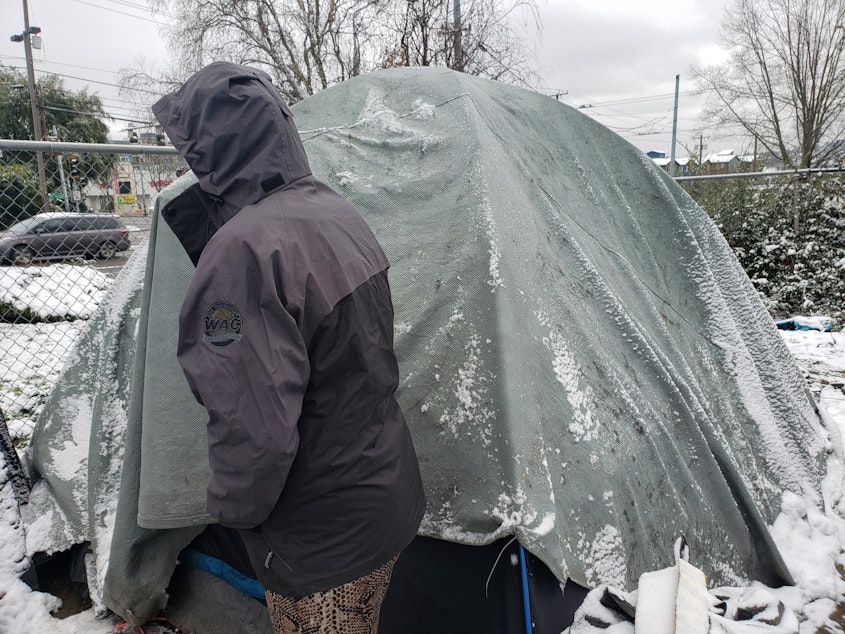Burning hand sanitizer and other ways Seattle homeless are braving cold nights

This is the third winter Sarah Clark is living outside. She and her boyfriend live in a tent next to Interstate 5 in the University District.
Clark said they’ve started fires inside their tent by burning Germ-X hand sanitizer. She’s aware of the danger of carbon monoxide poisoning and said she ventilates the tent during fires.
"A friend of mine actually passed away,” Clark said. “He was living in his vehicle and I think that he didn't know to vent his heater.”
There's shelter available in Seattle, but Clark, her boyfriend, and others prefer to sleep outside, burning fuels inside cold tents. There are several reasons why people who are homeless don't want to go to a shelter.
For Clark, it would mean abandoning her possessions, and possibly sleeping apart from her boyfriend.
“I don’t want to be separated from him,” she said.
Sponsored
Most of the shelters do allow couples but another barrier for Clark is her tent full of possessions, like the generator and her boyfriend’s bike.
“I don't know what we would do with everything,” she said waving a hand toward the tent, “we don't want to just abandon everything and then have to start all over again.”
Mark Reardon, a spokesperson for the Seattle Human Services Department, told KUOW the city’s Navigation team, which does outreach to people experiencing homelessness, is accommodating storage requests during this winter weather but could not transport mattresses or large pieces of furniture.
Another reason Sarah Clark and her boyfriend hunkered down through the cold is because most severe weather shelters are only open at night.
Mats at Seattle Center’s Exhibition Hall are available until 7 a.m. King County’s Administration Building, which doubled the number of available beds from 50 to 100, closes at 6 a.m. People sleeping at these shelters have to find a day center, coffee shop, or ride a bus to stay warm during the day.
Sponsored
At an encampment near Clark, a man named Nicky lives in a tent by himself. He also does not want to go to an overnight shelter, saying he has more freedom if he stays in his tent and mats on the floor don’t appeal to him.
"Some of us have drug and alcohol problems,” Nicky said, “so that's always going to be another factor that plays into shelter life as well."
Lack of privacy, the smells, and social anxiety are also factors, he said. Coffee shops or the nearby Blue Moon Tavern are a refuge from the cold when he can afford it. He calls hand warmers a godsend. In his tent he has blankets and uses a burner for heat when he has propane.
"I always keep an eye on it,” he said, “just burn it for about 15 minutes and keep the place lined with emergency blankets, that way it stays warm in there."
Those 15 minutes of burning gives him a couple of hours of warmth. He said he doesn't always make enough money holding a sign along the side of the I-5 on-ramp to afford the fuel.
Sponsored
"I mean, it's only like seven bucks for two cans, but if you don't make that much on the ramp you gotta eat,” he said, “you gotta have something to drink."
His other strategy for staying warm is to keep moving and starts his day with a walk to nearby food bank.
"It helps a lot plus, you know, it keeps the circulation going,” he said while walking, “it keeps you in shape."
As for Clark, she and her boyfriend were able to buy a generator with money from her boyfriend's job to heat their tarp-covered tent. They also stocked up on propane to power a small heater, but this week’s weather has made it tough to keep warm.
“Tents don't hold heat very well,” she said, “so just body heat and lots of blankets. We've been sleeping fully dressed with hand warmers and gloves on all the time.”
Sponsored
Outreach workers were out in the city this week making contact with people like Nicky and Sarah Clark, letting them know their options and urging them to come inside. The city’s Human Services Department said transportation was made available for people who needed it. During the first two days of the severe cold and snow the city said it spoke to 263 people living outside, 41 accepted an offer to go to a shelter.
For Sarah Clark and Nicky, the reasons they avoid shelters during the rest of the year – lack of privacy, having to leave behind belongings, or be separated from partners – still exist during wintry weather.
The public can contact the city’s emergency outreach teams at 2-1-1 if they see someone sleeping outside and in need of help.
KUOW has compiled a list of available severe weather shelters that be accessed here.





